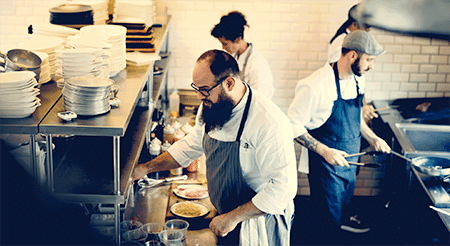Paying restaurant employees is one of the largest costs for a restaurant. And while there are many aspects of the restaurant industry you may not have control over (hello, unexpected weekend thunderstorms!), labor is your most controllable cost.
Understanding your restaurant labor cost, and how to adjust it, can increase your restaurant profitability. With birds-eye-view analytics like the daily flash report from your restaurant accounting software, you can use up-do-date information to review, track, and adjust your labor costs.
What is a daily flash report?
A restaurant’s flash report is a consolidated report that provides several key metrics about labor data: sales, labor as a percentage of sales, labor goals, comps and discounts, and other information. A flash report isn’t as widespread as a daily sales summary, or P&L report, and it doesn’t include inventory costs or other cost of goods metrics. But the flash report can provide key insights into your biggest variable expense – labor.
Understanding your labor metrics is essential for your restaurant profit margin. Food and labor are, generally, the two largest cost categories for most restaurants. But with labor costs increasing, due to higher minimum wages and increased competition for workers, labor can start to eat into restaurant margins. Tracking your labor, daily, can help you actively manage your labor costs relative to your sales – helping you lessen the impact of higher wage costs.
What labor cost metrics should I be tracking?
The first metric to consider is your labor cost – the amount your restaurant spends on labor. While some restaurateurs look only at unburdened labor, the direct cost of hourly worker shifts, a full view of your labor costs can help you avoid any unwelcome surprises in your restaurant accounting later. Fully burdened labor costs include salaried and hourly employee wages, as well as payroll taxes, worker’s comp, bonuses, overtime, health care, and other employee benefits.
However, the most important metric to measure is not just the cost of labor, but the labor cost as a percentage of total volume of sales. If a restaurant makes $30,000 a week, and the total labor cost is $7,500, the labor cost as a percentage of sales is 25% (this percentage, combined with the food cost, is what makes up your prime costs).
It isn’t enough to just know the labor cost, without knowing the labor cost compared to revenue. Say you have a restaurant that is full every night, and with a certain number of staff members, the labor cost comes to 25% of revenue. But if that restaurant starts to only be half-full each night, and it kept the same number of staff, labor costs could jump to over 50%. In both scenarios, the labor cost is the same – but without knowing the bigger picture of labor cost as a percentage of sales, you cannot understand how that labor cost is truly affecting your bottom line.
Although it can be helpful to compare labor cost percentages against average restaurant industry standards, different types of businesses can vary widely. Fine dining, fast casual, and quick service establishments will all have different labor costs as a percentage of sales, depending on their pricing, quality of food and service, state minimum wage, product and beverage sales, and a host of other factors.
To meet your desired profit margin, you should be working to keep your labor costs at whatever desired percentage of sales matches your business model. Having a restaurant accounting system that allows you to enter your sales per labor hours goal can help you track this goal.
Daily Flash Reports: helping you save on your labor costs
A daily flash report is the most effective way to stay on top of labor costs and make data-driven adjustments to lower your controllable labor costs. If you track your daily labor costs, you can measure them against your benchmarks and make adjustments in real time.
 A few extra employees per shift, or some employee overtime each week, significantly impacts your bottom line over the course of a month or a quarter. Catching anomalies in your labor data in the moment allows you to correct scheduling issues as they happen, instead of missing the opportunity for a healthier restaurant margin.
A few extra employees per shift, or some employee overtime each week, significantly impacts your bottom line over the course of a month or a quarter. Catching anomalies in your labor data in the moment allows you to correct scheduling issues as they happen, instead of missing the opportunity for a healthier restaurant margin.
There are many ways you can use daily flash reports and your restaurant management platform to control your labor costs and make informed decisions about staff scheduling. Using restaurant accounting software that allows you to track how your labor compares to your labor percentage goals, on a daily or even hourly basis, can show you where to adjust employee scheduling based on business trends. You can also compare the hours your employees have actually worked versus how many they were scheduled for. This can allow you to pinpoint employees clocking in or out of their schedule time, allowing you to place controls with your restaurant management software to curb excessive labor costs or overtime.
The flash report also contains snapshot information about employee comps and discounts, allowing you to pinpoint where you should investigate erroneous discounts or meal comps for non-business reasons. Daily tracking of comps and discounts can help you spot any patterns, saving you time and resources.
Conclusion
Labor is your most controllable cost – and tracking it daily helps you access, review, analyze, and adjust how it affects your bottom line. Profit margins in the restaurant industry are generally lower than in other consumer businesses, so there is less room for error in your controllable costs. Make informed decisions about the day-to-day strengths and weaknesses of your business, based on up-to-date data, with daily flash reports and labor data analytics.
If you would like to optimize your labor spend, consider a comprehensive, restaurant-specific management solution. Beyond daily flash reports and other labor metrics, Restaurant365 includes an employee scheduling feature that helps reduce labor costs, streamline communication and promote employee engagement. Restaurant365 incorporates restaurant accounting software and restaurant operations software into an all-in-one, cloud-based platform that seamlessly integrates with Point-of-Sale systems, payroll providers, food and beverage vendors and banks. Learn more about the restaurant employee scheduling feature within Restaurant365 on our website.



